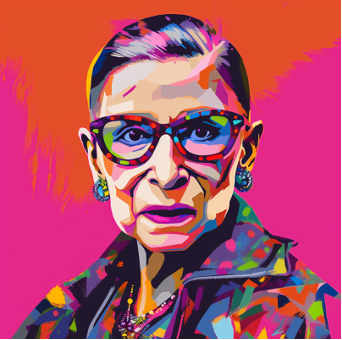“After Warhol, what uses are sufficiently ‘transformative’? Answers to [that and a number of other] questions are likely to impact the fair use analysis as applied to generative AI platforms.”

Midjourney prompt: “warhol’s ghost in the machine sci fi”
On May 18, 2023, the U.S. Supreme Court answered an exceedingly narrow question of copyright law with potentially sweeping impact: did the purpose and character of Andy Warhol’s below ‘Orange Prince’ work—as used on a 2016 Condé Nast magazine cover—support fair use of Lynn Goldsmith’s photograph of famed musician Prince Rogers Nelson a/k/a Prince?
In a 7-2 decision, the Court found that it does not, calling into question nearly 30 years of fair use jurisprudence, arguably narrowing the scope of that doctrine, and potentially threatening disciplines that rely on it, e.g., appropriation art. The decision is also sure to impact generative artificial intelligence (“AI”), an emerging technology that is also likely to rely heavily on fair use.
The Warhol Decision
Andy Warhol died in 1987, but his copyrighted works live on. Today, those works are licensed by The Andy Warhol Foundation for the Visual Arts, Inc. (“AWF”). In 2016, AWF licensed to Condé Nast Warhol’s ‘Orange Prince,’ an unpublished, unlicensed silkscreen artwork of Lynn Goldsmith’s 1981 black-and-white photograph, to use on a magazine cover to memorialize Prince. Goldsmith objected to ‘Orange Prince’ after learning of it from the commemorative issue, AWF responded with a declaratory judgment action, and Goldsmith counterclaimed for infringement. The district court found for AWF on fair use grounds, the U.S. Court of Appeals for the Second Circuit reversed, and the U.S. Supreme Court—faced with the narrow question of whether the first fair use factor favored Goldsmith or AWF—affirmed the Second Circuit’s ruling.
The majority and dissenting opinions starkly disagree on how to apply the fair use factors. Whereas the dissent focuses on the purpose and character of Warhol’s creation of Goldsmith’s photo to create ‘Orange Prince,’ the majority all but disregards it, and relies on the purpose and character of AWF’s licensing of ‘Orange Prince’ for use as a magazine cover. And whereas the majority finds that the mere addition of new expression cannot sway the first factor in a copyist’s favor without swallowing the author’s derivative works right, the dissent posits that the fourth factor— the effect on the author’s potential market for the work—addresses that concern.
Warhol raises many questions. After Warhol, what uses are sufficiently “transformative”? Does Warhol square with the Court’s 2021 copyright fair use decision in Oracle v. Google? And does it square with the Second Circuit’s decisions in the Author’s Guild and HathiTrust cases (which the Court tacitly endorsed when it declined to grant certiorari in Author’s Guild)? Answers to those questions are likely to impact the fair use analysis as applied to generative AI platforms.
What is Generative AI?
Generative AI refers to services comprised of algorithms that users can interact with to create content. A hallmark of these generative AI models is their “training” with huge datasets, i.e., millions if not billions of images, in an iterative process whereby the generative AI model “learns” to generate increasingly accurate images in response to text prompts. Critically, some of the most popular generative AI text-to-image models have been trained on unlicensed datasets.
Artists use generative AI to create images in various ways. Some engage in a collaborative process involving iterative re-submission of AI-generated images to the generative AI platform. Others take an AI-generated image and modify it with traditional graphic design tools. Still others use AI-generated images as inspiration to create new works using non-AI tools. In each case, however, users benefit from a generative AI platform that may be “trained” on unlicensed images.
Copyright Fair Use in the Generative AI Context
Recent litigation involving generative AI platforms suggests that the scope of fair use will undoubtedly be an issue to consider. In its motion to dismiss a copyright infringement complaint over its use of unlicensed training sets, Midjourney, Inc. referred to its “obvious fair use defenses” to copyright infringement. Yet, following the Supreme Court’s Warhol decision, exactly how “obvious” is that defense?
Before Warhol, it seemed likely that a court could find the creation of a generative AI platform using unlicensed training data to be insulated by fair use; arguably, the use of content to “train” a platform that generates content is precisely the kind of “highly creative and innovative” use that courts have found transformative. Google LLC v. Oracle Am., Inc., 141 S. Ct. 1183, 1203 (2021). In fact, if Google’s searchable databases are transformative, one could reasonably argue that generative AI text prompts—much like word searches—must also have a different “purpose, character, expression, meaning, and message from the [work] from which [they are] drawn” and are thus “quintessentially transformative use[s].” Authors Guild v. Google, Inc., 804 F.3d 202, 217 (2d Cir. 2015) (quoting Authors Guild, Inc. v. HathiTrust, 755 F.3d 87, 97 (2d Cir. 2014)).
Warhol, however, complicates that analysis. In Warhol, the Court, applying the first fair use factor, held the purpose and character of Warhol’s ‘Orange Prince’ was similar to Goldsmith’s, as both works were licensed for use in popular magazines. Does that mean that a plaintiff artist can defeat a generative AI platform’s fair use defense by licensing his or her work to similar generative AI platforms? Or by pointing to other artists that have licensed their work to generative AI platforms? This, together with the Court’s admonition that a “transformative” use must “go beyond that required to qualify as a derivative” suggests that using an identical work, commercially, to do something that artists can and have already licensed, raises serious doubts about the strength of fair use as a defense to allegedly infringing creations of generative AI platforms.
Warhol’s Ghost Looms Large
Warhol’s work, as well as his posthumous celebrity status (which, given his oeuvre, is nothing short of ironic) continue to influence modern culture and push boundaries, most recently by testing the limits of copyright fair use. Not surprisingly, Warhol’s image, work, style, and legacy has also found its way into generative AI. Were he still alive today, chances are that Andy Warhol would himself be experimenting with generative AI. Fortunately for us, generative AI gives us a nearly limitless opportunity to experiment with Warhol.

Midjourney prompt: “ruth bader ginsburg in the style of andy warhol”

Midjourney prompt: “illustration of the supreme court in the style of Andy Warhol”

![[IPWatchdog Logo]](https://ipwatchdog.com/wp-content/themes/IPWatchdog%20-%202023/assets/images/temp/logo-small@2x.png)

![[Advertisement]](https://ipwatchdog.com/wp-content/uploads/2024/04/Patent-Litigation-Masters-2024-sidebar-early-bird-ends-Apr-21-last-chance-700x500-1.jpg)

![[Advertisement]](https://ipwatchdog.com/wp-content/uploads/2021/12/WEBINAR-336-x-280-px.png)
![[Advertisement]](https://ipwatchdog.com/wp-content/uploads/2021/12/2021-Patent-Practice-on-Demand-recorded-Feb-2021-336-x-280.jpg)
![[Advertisement]](https://ipwatchdog.com/wp-content/uploads/2021/12/Ad-4-The-Invent-Patent-System™.png)







Join the Discussion
One comment so far.
Anon
June 8, 2023 06:33 pmIn a word, the answer to the question of the article’s title is:
Nothing.
Leastwise in the current hue and cry from creatives in regard to the part of AI that counts: ingestion for training.
If indeed the Court has chosen to have a narrow focus (and plenty of discussion may be had even on that point), then the functionality of AI will not — and cannot — be reached with the Warhol case.
At all.